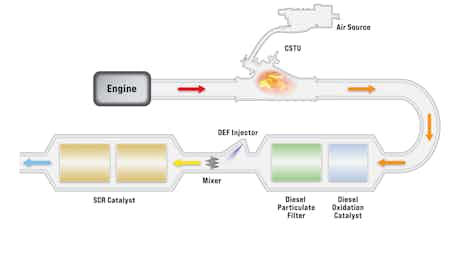Euro 6 emissions standards: what you need to know
November 01, 2022 by carwow staff

European emissions standards have become increasingly stringent since they were introduced in 1992, and the impact they have on motorists has increased markedly in recent years.
You may have heard the term Euro 6 being thrown around, but what does it mean, and why do you need to know?
Euro 6 is the name given to the current and sixth iteration of European emissions standards, which were first introduced in 1992. Euro 6 standards arrived in September 2014, but they weren’t introduced in one fell swoop: from 2014 all new ‘type approvals’ (freshly developed models) had to be Euro 6 compliant, with all newly registered cars having to meet them by September 2015.
Car makers were given a further dispensation, though: any cars built and dispatched prior to June 2015, and sold before September 2016, did not have to meet Euro 6 standards. So while it is likely most post-2015 cars will be Euro 6 compliant, some cars from 2016 may not be.
Euro 7 standards, meanwhile, are expected to be introduced in 2025 and will be even stricter than their predecessors.

What are the Euro 6 emissions standards?
The European emissions standards were introduced in 1993 to reduce the amount of pollution generated by cars. Specifically, Euro 6 standards target nitrogen oxide (NOx), carbon monoxide (CO), hydrocarbons (THC and NMHC) and particulate matter (PM).
Nitrogen oxide (NOx) is a pollutant which has some serious health implications, as well as being harmful to the environment. Particulate matter, meanwhile, found to cause breathing and pulmonary problems.

Euro 6 standards are different for petrol and diesel cars, as these fuels produce different levels of pollutants as they are burnt. Diesel engines produce more NOx than petrol ones, for example, and therefore the limit is set higher, at 0.08g/km, as opposed to 0.06g/km for petrol models.
The standards that all new cars have to meet are listed below.
Petrol cars:
CO: 1.0 g/km
THC: 0.10 g/km
NMHC: 0.068g/km
NOx: 0.06g/km
PM: 0.005g/km
Diesel cars:
CO: 0.5g/km
HC+NOx: 0.17g/km
NOx: 0.08g/km
PM: 0.005g/km
Did ‘Dieselgate’ make Euro 6 emissions tougher?
The ‘Dieselgate’ scandal saw a number of companies accused of fitting ‘defeat devices’ to cars. These devices could detect when a car was in a laboratory being subject to emission testing, modifying the behaviour of the engine so it emitted fewer pollutants.
To compensate for disparities between laboratory results and real-world emissions, a new on-road emission testing procedure was introduced as part of the type approval process that checks vehicles are compliant with Euro 6 standards.
These tests are known as ‘Real Driving Emissions’ (RDE), and involve driving vehicles on the road and measuring their emissions with portable equipment, though RDE2 tests complement rather than replace lab-based assessments.
Why are Euro emissions standards important?
Euro standards were originally developed to ensure car makers designed and built cars that did not pollute more than a certain amount, but they have since been adopted by various authorities to control localised pollution.

London’s Ultra Low Emission Zone (ULEZ) is the best-known example of this, with the recently expanded zone now encompassing every part of London inside the North and South Circular. The ULEZ sees drivers of non-compliant cars entering the zone charged £12.50, with the scheme operating 24 hours a day, seven days a week. Diesel cars not meeting Euro 6 standards, and petrol cars not meeting Euro 4 standards (which were introduced between 2005 and 2006) incur the charge. You can check if your vehicle is compliant using our free ULEZ checker.
London isn’t the only place with Euro standards on its mind, though: a number of towns and cities across the country have introduced or are considering schemes that are based around cars’ emissions, so it’s worth knowing what these standards are, and which one your current car, or any potential purchase, meets. You can use our handy clean air zone checker to see the boundary of these low emission zones across the UK, and whether your vehicle is compliant. (For specific Scotland-related advice for Low Emission Zones read: Low Emission Zones Scotland .)
In addition, the RDE tests mentioned above also have taxation implications. RDE was introduced in stages, with the second stage, RDE2, having stricter criteria than the first. The UK company-car tax system adds a 4% surcharge to diesel cars not tested under RDE2 criteria.
How are new cars tested for emissions?
Since 2018, all new cars have been tested using World Harmonised Light Vehicle Testing Protocol (WLTP), which replaced the old New European Driving Cycle (NEDC) testing procedures.
Under the old NEDC system, cars were put through a cycle of accelerating, coasting and slowing down, which wasn’t considered representative of how people actually drive. This led to high economy and low emissions figures that could be challenging to meet during real-world driving.
New WLTP testing involves running the car at higher speeds for longer, as well as accelerating harder, more accurately reflecting real driving. These tests are observed by government officials and the cars are randomly selected from the production line.
Most Euro 6 testing is performed under controlled conditions, with the ambient temperature, fluid levels and tyre pressures all monitored to ensure consistency between models. Cars also now undergo real-world driving emissions testing (RDE), though, and this takes place out on the open road rather than in laboratory conditions. Stage 1 of RDE tests allowed cars to emit 2.1 times more NOx on the road than they do in the laboratory; RDE2 reduces this conformity factor to 1.5 times.
What are the benefits of a Euro 6 car?
Aside from being better for the environment, there are a few benefits to owning a Euro 6 compliant car. If you own a Euro 6 diesel car, you don’t have to worry about London’s Ultra Low Emission Zone charges. Euro 4 petrol cars are also exempt. To find out if your vehicle is ULEZ compliant, simply enter your registration number into our handy ULEZ checker tool.
Euro emissions standards history
European emissions standards were introduced in 1993 with Euro 1, and have got gradually more stringent over time until we get to today’s Euro 6 regulations. Euro 7 is expected to come into force from 2025, although this isn’t yet confirmed.
Euro emission standards for petrol cars:
| Euro Standard | Date | CO | NOx | PM |
| Euro 1 | January 1993 | 2.27g/km | 0.97g/km | N/A |
| Euro 2 | January 1997 | 2.2g/km | 0.5g/km | N/A |
| Euro 3 | January 2001 | 2.3g/km | 0.15g/km | N/A |
| Euro 4 | January 2006 | 1g/km | 0.08g/km | N/A |
| Euro 5 | September 2011 | 1g/km | 0.06g/km | 0.005g/km |
| Euro 6 | September 2015 | 1g/km | 0.06g/km | 0.005g/km |
Euro emissions standards for diesel cars:
| Euro standard | Date | CO | NOx | PM |
| Euro 1 | July 1993 | 2.72g/km | 0.97g/km | 0.14g/km |
| Euro 2 | January 1997 | 1g/km | 0.7g/km | 0.08g/km |
| Euro 3 | January 2001 | 0.64g/km | 0.5g/km | 0.05g/km |
| Euro 4 | January 2006 | 0.5g/km | 0.25g/km | 0.025g/km |
| Euro 5a | September 2011 | 0.5g/km | 0.18g/km | 0.005g/km |
| Euro 6 | September 2015 | 0.5g/km | 0.08g/km | 0.005g/km |
What comes next for emissions regulations?
You might imagine that after Euro 6 standards must come Euro 7, and you would be correct. Euro 7 rules are due to be introduced in 2025, though there remains some lack of clarity about what they will or will not require.
Sources previously indicated that Euro 7 proposals could be so onerous that they would effectively kill off petrol and diesel engines as meeting the rules would bring about enormous cost that would make such cars significantly more expensive. Subsequently, a report obtained by the website Politico indicated that the EU would not make Euro 7 rules prohibitively difficult to meet.
Does Brexit have any impact on Euro emissions standards?
No, in a word. While the UK’s departure from the European Union allows deviation from EU rules, in this instance it has been decided that the UK will adopt Euro standard rules.
How do I find my car’s Euro emissions standard?
If you take the date your car was registered and compare it to the table above, there’s a good chance your car complies with the relevant standard. Your car’s registration papers (also known as the logbook, or V5C) may also list its Euro standard, while some cars have their Euro standard on a label in the driver’s door jamb.
You can also enter your car’s registration into our ULEZ checker to find out if your car incurs the charge, which means it is either a pre-Euro 4 petrol, or a pre-Euro 6 diesel model.
Contact your local dealer or your car’s manufacturer if these methods don’t bear fruit.
Change cars online with carwow
Looking for an easy way to change your car? Then carwow is the place to go. You can sell your car online for a great price, and get the best deals on a new one. All through our network of trusted dealers and all from the comfort of your home. Tap the button below to get started today.















